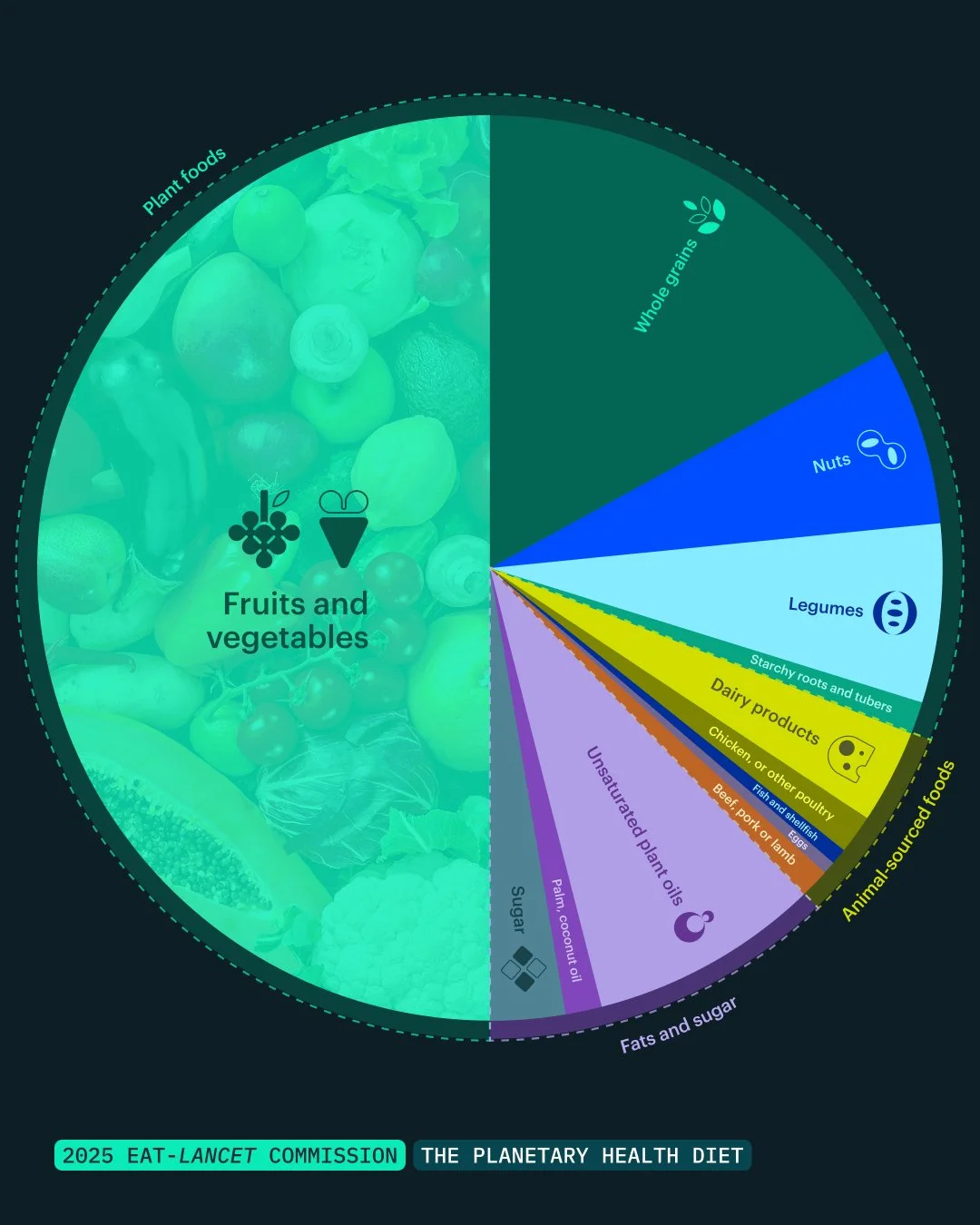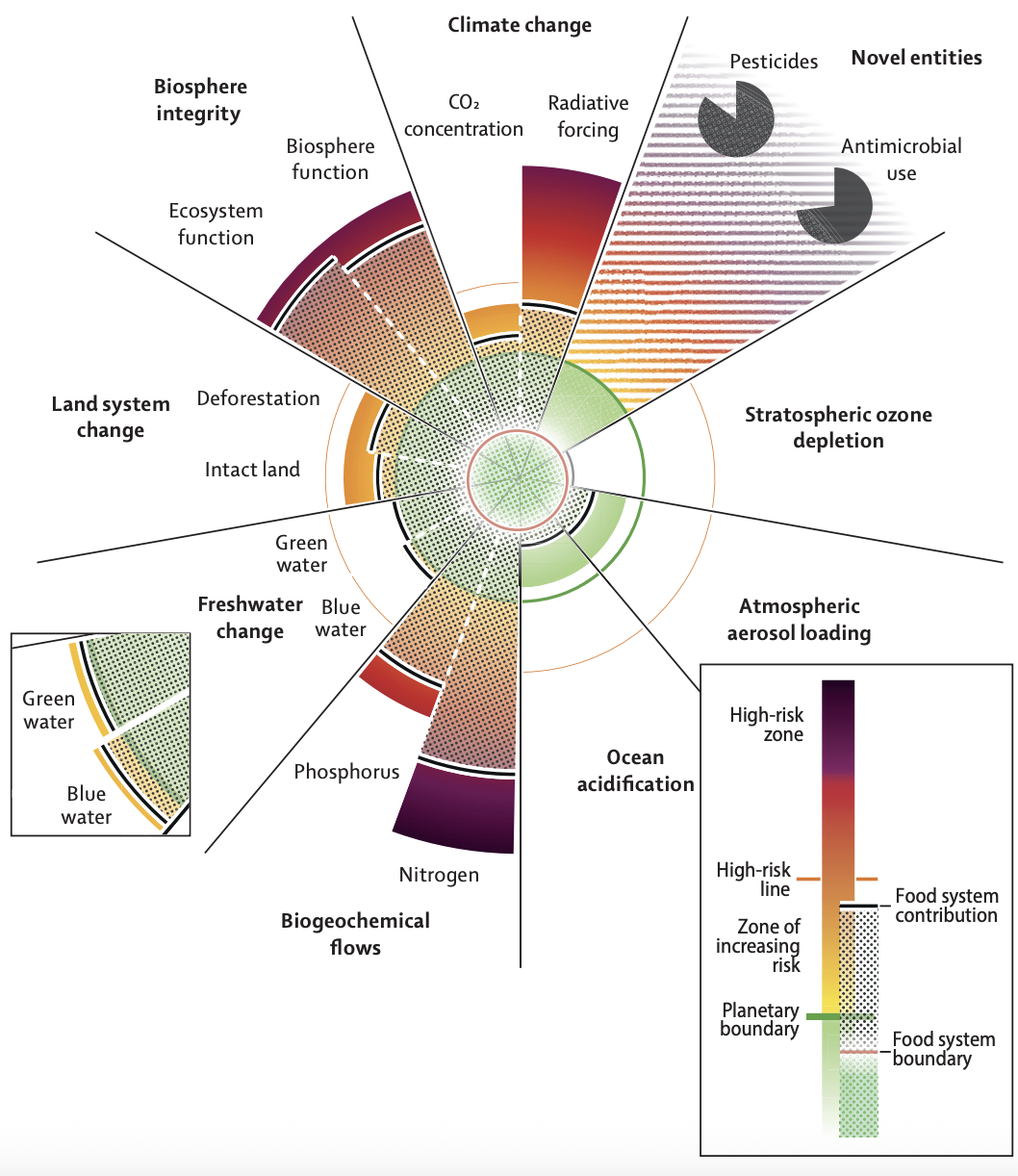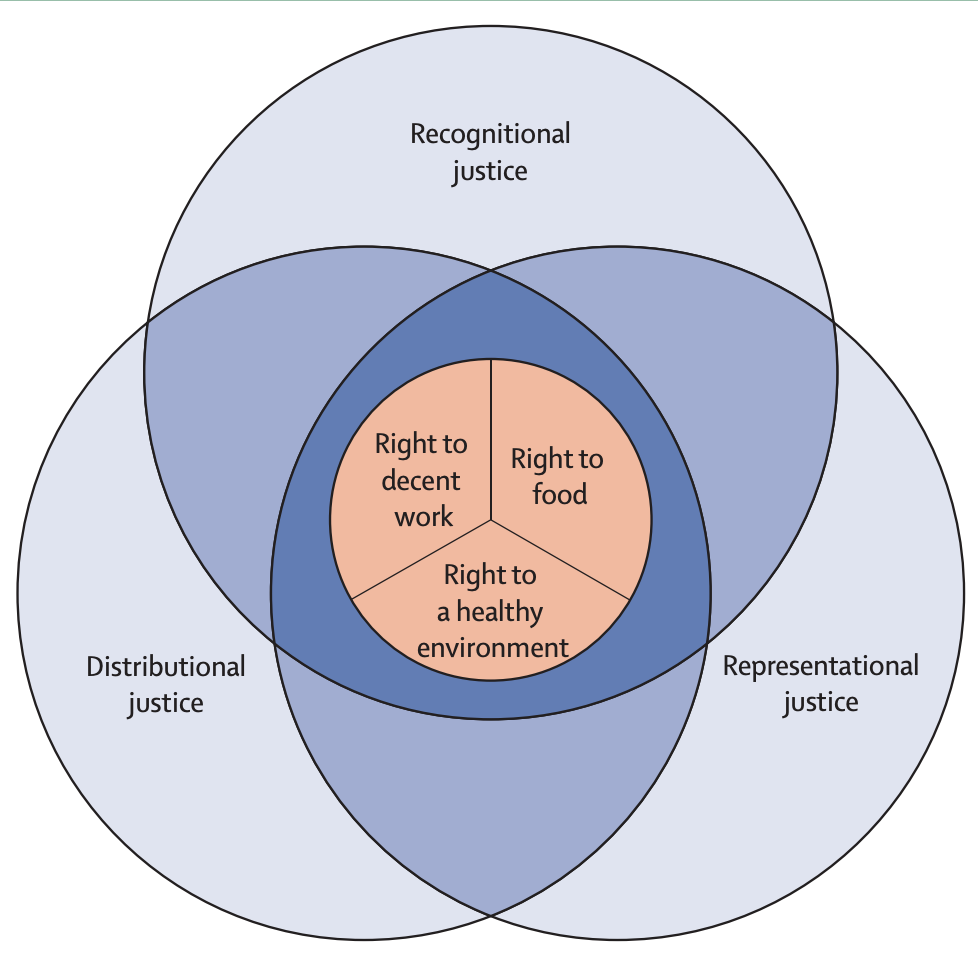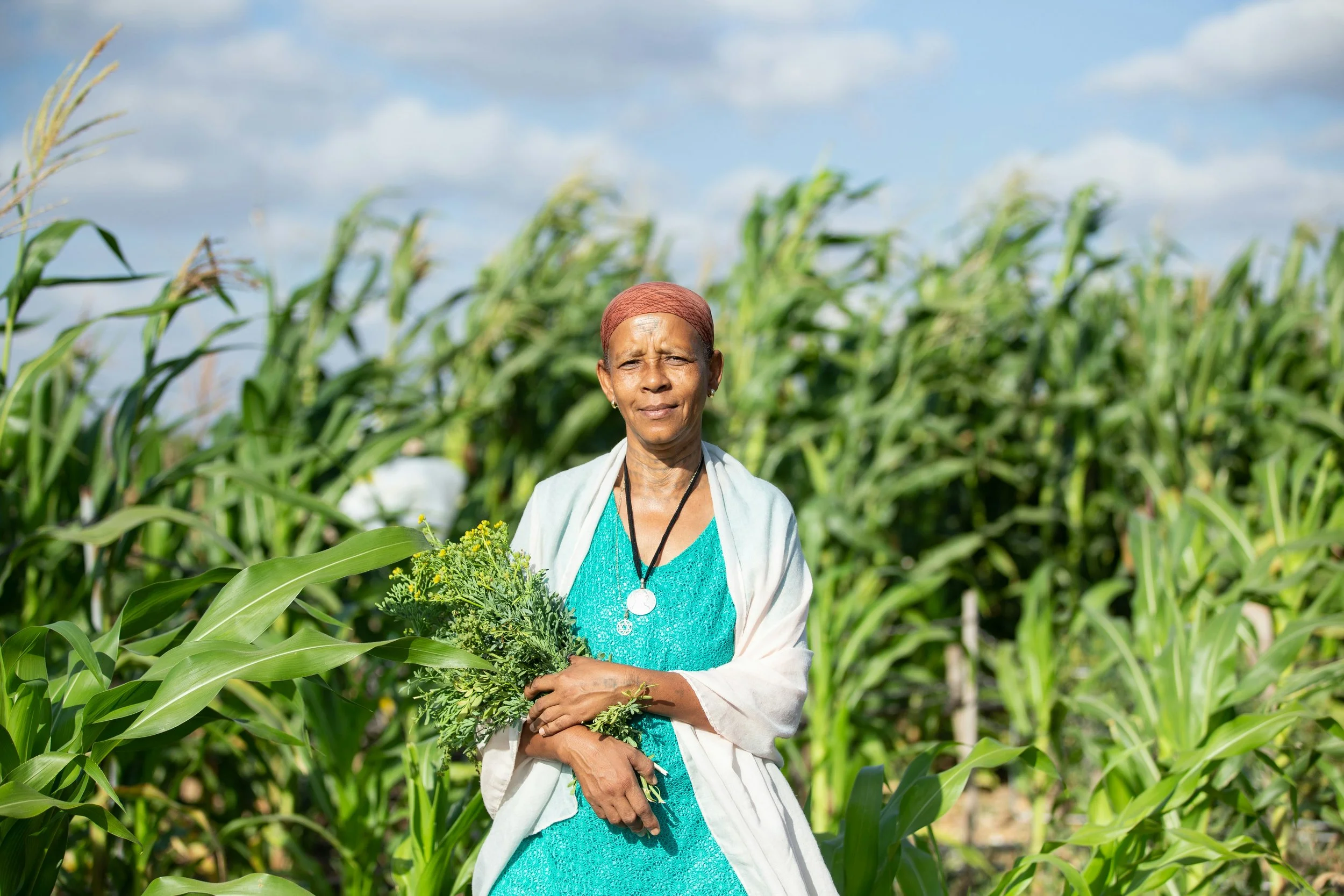The Great Food Transformation
The newly updated EAT-Lancet Commission on Healthy, Sustainable, and Just Food Systems is a global reset moment, providing a science-based framework for governments, civil society, and business to strengthen resilience, secure stability, and build healthier futures.
The 2025 Commission addresses interlocking issues, reiterates the planetary health diet, and presents new assessment of food systems' role in driving planetary boundary transgressions.
The Commission outlines how unhealthy diets underpin 15 million avoidable deaths every year, while over half the world’s population struggles to access healthy diets. Food production is also the leading driver of biodiversity loss, water scarcity, antimicrobial overuse, soil degradation, and climate change.
Furthermore, the imbalance remains sobering: the food system generates $10 trillion in annual value but causes $15 trillion in costs to health, society, and the environment.
By 2050, the Commission shows that the global food system must deliver three interconnected outcomes: healthy diets for all, food production within planetary boundaries, and justice at the core. Together, these outcomes define the safe and just space in which humanity can thrive.
A Shifting Global Landscape
Since the first EAT-Lancet publication in 2019, instability has become more visible. Geopolitical shocks, climate change, rising food prices, and the pandemic have exposed deep vulnerabilities in how we produce, trade, and consume food. These stresses show us not only the risks of continuing with business as usual, but also the scale of opportunity if transformation is accelerated.
The EAT-Lancet 2025 framework identifies three interconnected priorities - health, environment, and justice - which together define the pathway for transforming food systems towards a safe and just future.
Health: The Planetary Health Diet
The Commission reaffirms the Planetary Health Diet (PHD) as a critical component of delivering food system transformation in the decades ahead. It is balanced, plant-rich, culturally adaptable, flexible, and underpinned by strong evidence.
Importantly, the 2025 PHD was modelled using evidence from a wider range of populations and world regions than in 2019, strengthening its global applicability.
Compared to average diets, shifting to the PHD would:
Improve health outcomes by reducing all-cause mortality and diet-related chronic diseases, including cardiovascular disease, type 2 diabetes, obesity, cancer, depression, and dementia.
Free up land and reduce greenhouse gas emissions.
Lower pressure on other planetary boundaries including soils, water, and biodiversity.
Improve agricultural productivity, cut food loss and waste, and reduce land use.
The PHD also recognises variability in nutritional needs across age, sex, body size, activity level, pregnancy and lactation, and genetic factors.
The PHD reduces all types of malnutrition, including undernutrition, and in the Commissions words is…
“Adequate, diverse, balanced, and moderate.”
The recommended intakes for different food groups (see table) are given as averages and ranges, showing the PHD is flexible and adaptable to cultures, contexts and needs.
Planetary Boundaries: Staying Within the Earth’s Safe Operating Space
In 2025, the Commission assessed food across all nine planetary boundaries (up from five in 2019) and proposed specific food system boundaries.
The findings are stark: six of the nine boundaries are already transgressed, with food responsible for five - land-system change, biosphere integrity, blue water, nitrogen, and phosphorus. The food system is also shown to significantly impact the climate boundary and ocean acidification, and is accountable for nearly all nitrogen and phosphorus overshoot.
The conclusion reached by the Commission is clear: there can be no safe solution to multiple climate and biodiversity crises without food systems transformation.
Regenerative agriculture, described in the report as sustainable ecological intensification, is highlighted as a key pathway for making progress across multiple boundaries. When combined with circular nutrient systems, it can:
Reduce greenhouse gas emissions.
Increase carbon sequestration.
Decrease land and water use.
Improve nitrogen and phosphorus efficiency.
Justice: A Driving Force for Transformation
Justice is a goal and a driving force for food systems transformation in EAT-Lancet 2025. The Commission places justice at the heart of the food system, recognising that resilience and legitimacy depend on embedding fairness throughout.
It outlines nine foundations for justice, including:
Access to healthy diets.
The right to live and work in a healthy environment.
The right to live in a stable climate system.
Living wages and secure livelihoods.
Participation in building the food system.
Currently, half the world’s population lives below these foundations. Unequal access to healthy environments, worsened by the food system’s breach of planetary boundaries, is one of the starkest injustices.
The distribution of responsibility is equally unequal: the diets of the richest 30% of people contribute more than 70% of food-system environmental pressures.
Justice is therefore both a moral responsibility and a strategic imperative.
Eight Solutions for Healthy, Sustainable, and Just Food Systems
The Commission sets out an eight-point plan to reorientate the food system:
Change food environments to increase demand for the Planetary Health Diet.
Promote and protect traditional diets.
Implement regenerative agriculture.
Regulate to prevent destruction of intact ecosystems.
Reduce food loss and waste through infrastructure, movement, and behaviour change.
Secure decent working conditions.
Ensure voice and representation.
Recognise and protect marginalised groups.
The benefits of transition of food systems are valued at USD 5 trillion per year. The Commission makes clear that delivering these solutions will require USD 200–500 billion annually - far less than the cost of inaction.
Progress: Signs of Momentum
Since 2019, significant developments have been achieved in the food system. These show us that progress is achievable and many of the solutions already being delivered are ready to scale.
Some examples within our eco system (if you have more to add, send them to us for the case study we are developing to share)
Policy:
Two-thirds of countries have adopted National Food Systems Pathways
290 cities (490 million people) have signed the Milan Urban Food Policy Pact
Kunming–Montreal Global Biodiversity Framework (2023) sets explicit food system targets.
Nearly 20 C40 cities, including Milan, Barcelona, and London, are reshaping procurement to align with planetary health diets.
Business:
In the Netherlands, 11 supermarkets covering 90% of market share are committed to 60% plant-based protein by 2030.
Retailers such as Ahold Delhaize pledge to shift 50% of protein sales to plants by 2030.
Germany’s REWE Group is embedding diversification and calling for a national protein plan.
Arla Foods is cutting on-farm emissions by 30% by 2030, mapping land and water impacts, and aligning with new FLAG standards.
Compass Group has reformulated 90,000 recipes and set a 40% plant-based meals target by 2030.
Sodexo pledges one in three plant-based meals by 2025.
Aramark is scaling planetary health menus across European universities.
Citizens:
Two-thirds say they are already changing, or considering changing, their diets to be healthier and more sustainable.
These shifts send powerful demand signals through supply chains. Businesses embedding health and sustainability as growth drivers are already gaining operational resilience, lower regulatory risk, preferential access to ESG capital, and stronger consumer trust.
Looking Ahead
The EAT-Lancet 2025 framework reaffirms that the science is unambiguous, the economics compelling, and the multiple benefits of transformation span human health, planetary stability, and social justice. What remains is action, with courage, collaboration, and speed - to turn evidence into transformation at pace and scale.






